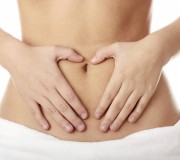 Brown stringy discharge is a symptom that bothers many women of different ages throughout their reproductive years. It can appear because of different reasons and is diagnosed depending on the accompanying symptoms, relative to the menstrual cycle, age, living conditions and certain medical tests. In this article it will be explained, why you may have this discharge in the middle of the menstrual cycle, instead or after your period. If you have more specific questions, the answers to them can be given only by a highly skilled specialist after further medical examinations. Read more..
Brown stringy discharge is a symptom that bothers many women of different ages throughout their reproductive years. It can appear because of different reasons and is diagnosed depending on the accompanying symptoms, relative to the menstrual cycle, age, living conditions and certain medical tests. In this article it will be explained, why you may have this discharge in the middle of the menstrual cycle, instead or after your period. If you have more specific questions, the answers to them can be given only by a highly skilled specialist after further medical examinations. Read more..
Brown Discharge


 Normal discharge in color and consistency is clear and yellowish or cloudy and white. These natural secretions maintain the cleanliness of the vaginal area. Sometimes there is a variation in this type of discharge due to reasons like changes in the menstrual cycle, improper nutrition, early pregnancy and birth control pills intake. Any strange symptom regarding vaginal secretions could indicate infection or disease, so it definitely mustn`t be ignored. Remember, that prevention is always better than cure! Read more..
Normal discharge in color and consistency is clear and yellowish or cloudy and white. These natural secretions maintain the cleanliness of the vaginal area. Sometimes there is a variation in this type of discharge due to reasons like changes in the menstrual cycle, improper nutrition, early pregnancy and birth control pills intake. Any strange symptom regarding vaginal secretions could indicate infection or disease, so it definitely mustn`t be ignored. Remember, that prevention is always better than cure! Read more..

Brown vaginal discharge is not always the cause for concern. Women are aware of the kind of discharge down there every now and then. It is a natural procedure of cleaning the vagina. Discharge is the flaking of cells and fluids incessantly, but its consistency varies according to the monthly cycle of the women. It ranges from whitish watery discharge to slightly thick consistency.
What roots the brown vaginal discharge?
- Normal conditions – Vaginal secretion should never be regarded as unhealthy, but brown discharge is mostly linked with the old endometrial tissues. If your menstrual period is delayed you may get brown instead of the usual red coloured discharge. This also indicates that for some reason in your last period the complete uterine lining was unsuccessful in making a timely exit. Therefore, what is seen now is the late exit.
- Grave conditions – In certain cases brown discharge from the vagina is a matter of medical concern, which is more threatening than remaining endometrial cells.
- Yeast infection – If the infection is extreme, when the menstrual cycle is nearby than it is rooted by Candida Albicans bacteria. It may be odourless or has a slight yeast odour.
- Vulvovaginitis – It is grounded by bacteria causing brown or yellow discharge with foul, fishy, and strong odour.
- PID or Pelvic Inflammatory Disease – It is a bacterial infection of uterus, ovaries, or the Fallopian tubes. It is a STD, usually caused by two kinds of bacteria – gonorrhoea and chlamydia. A foul odour, painful urination, bleeding after libido and lower back or pelvis pain are the common symptoms. You need to consult a doctor, if you experience these symptoms.
- Gonorrhea – With the other symptoms identical to PID the patient will suffer from mouth lesions.
- Chlamydia – Symptoms will be identical to PID, but the patient will start losing appetite and weight.
- Cervical cancer – The female will undergo vaginal pain, soreness during sexual intercourse and continuous brown, pink discharge having foul smell.
- Genital warts – genital warts are STD’s caused by the Human Papilloma Virus. Warts appear in the genital region and looks like cauliflower. A brownish vaginal discharge, bleeding and itching is experienced after intercourse.
- Menopause – Women may experience depression, sweaty skin, burning sensation in her mouth and brown vaginal discharge with unpleasant odour in the urine.
All the above grave conditions display brownish vaginal discharge, but it is essential to get a vaginal examination done by your doctor. Get it treated and cured. Do not get nervous if it is an STD, you are not an unclean person, but the disease is dirty. It is an infection transported through sexual contact meaning you are unlucky and not dirty.
Treatment from brown discharge
- For normal conditions – If the brownish vaginal discharge is just caused by old uterine cells then treating this condition is a simple process. Change your lifestyle, include better nutrition, regular workouts and drink plenty of water.
- For grave conditions – Treatments are aimed to treat specific diseases. The treatment options for grave conditions causing brown discharge includes prescription medicines, dietary supplements, chemotherapy, surgery, a Pap smear and regular visit to your doctor.

The main organ in women’s body that acts as ingress to the reproductive system is vagina. Like other body organs it has its own pH balance. The bacterium present in the vagina secretes a vaginal discharge (also known as Leucorrhoea), which maintains the healthy conditions and proper acidic pH in the vagina. This acidic pH element inhibits the occurrence of any infection and maintains a healthy vagina.
What is Vaginal Discharge?
Every woman has vaginal discharge. It’s a part of proper body functioning. In fact, dryness of the vagina is not a healthy sign. There must be fluids present in this genital organ. The tissues present on the walls of the uterus are removed every month through the menstrual cycle likewise the tissues and old cells on the walls of the vagina are eliminated daily through discharge.
The renewing of cells daily occurs due to the estrogen hormones. This hormone helps the glands in the cervix produce a small amount of fluid, which takes away the old cells that line the vagina. The amount the fluid secreted depends on the age, menstrual cycle and pregnancy. It starts with puberty in girls and ends with menopause. Healthy discharge doesn’t carry any strong odours or colour. The normal discharge keeps the vagina clean, as well as lubricated and free from germs and infection. One may feel wetness, but no irritation or soreness should be there. This is not related to fertility or infertility.
Things that might have a negative effect on discharge are
- Nutritional imbalance
- Emotional Stress
- Menstrual cycle
- Ovulation
- Pregnancy
Make sure you take a healthy diet with the proper proteins, carbohydrates and amino acids. Lead a proper lifestyle and exercise daily. Maintain hygiene levels during menstruation and change your sanitary napkin twice daily and avoid using tampons. During the middle of the menstrual cycle you may observe that the discharge is stringy and at the end it might become sticky. If you are going through stress and blood pressure you might have more discharge. Even women with the B+ blood group have a tendency to discharge more fluid. It’s very important to have proper libido to keep away the dryness of vagina.
Dryness of vagina
Dryness of the vagina is not a healthy sign. Women with any ovaries related problem or with athletic built have high levels of testorene (male hormones) and hence face this problem. When male hormone suppresses the female hormone the daily clearing of vaginal tissue stops and the area swells up. This may also lead to cancerous conditions. Even women, who sweat a lot, face this problem. The best way to curb the issue is to consult the doctor, as it is a typical problem and follow their advice.
Simple measures to maintain healthy vagina
- Wear cotton panty and change it twice daily.
- Drink loads of water.
- Maintain proper hygienic conditions.
- Clean your vagina twice a day.
- Don’t apply unprescribed creams or lubricants.
- Do the Pap smear test to rule out any possibility of infection.
- Maintain your blood sugar levels if you are diabetic.
